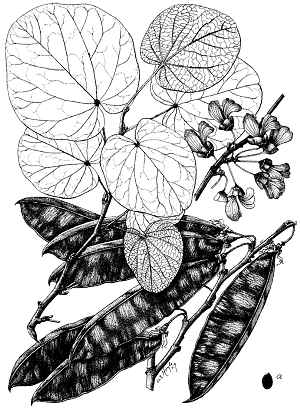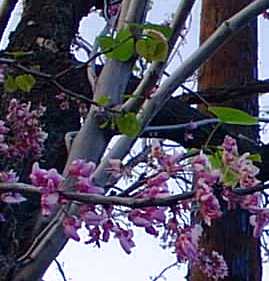Sunset®: 2-24
USDA: 8-11
Frost Tolerance: Hardy in Phoenix, needs several hours of temperature below freezing in winter in order to bloom
Sun Exposure: Full sun to part shade. Tolerates reflected sun.
Origin: Southwestern USA
Growth Habits: Deciduous shrub (occasionally evergreen in mild climate), up to 20 feet tall (6 m) or more
Watering Needs: Infrequent watering when established. Tolerates to be grown in lawn. Prefers good drainage.
Propagation: Seed or occasionally cutting, layering
- by cuttings.
- by layers.
- by seeds, in spring. Germinates at 70 degrees F. The seeds can be harvested in autumn. The seeds need stratify 40F 2-3mo.. The usual germination temperature is 70 degrees F.

Western Redbud (Cercis occidentalis), U.S.D.A. Drawing, courtesy Hunt Institute
Cercis occidentalis Torr. ex Gray, western redbud, is a leguminous shrub that grows from 7 to 20 feet tall with a dense rounded crown that almost reaches the ground. Western redbud, also known as California redbud, is currently recognized as Cercis canadensis L. var. texensis (S. Wats.) M. Hopkins. The leaves are simple, thick, round or reniform, and cordate at the base, and have from 7 to 9 prominent veins. They are winter deciduous; their autumn display of yellow turning to red and brown rivaling that of some eastern hardwoods.
Western redbud is a good soil stabilizer along streams, and can withstand periodic flooding. The flowers provide nectar to bees and the young shoots, leaves, and seedpods are browsed by goats, and to a limited extent by deer, sheep, and cattle. The browse rating for sheep and cattle is poor. Horticulturists have planted redbud in informal and formal gardens and landscapes since 1886 and it has been called one of California's most attractive flowering shrubs in gardeners' manuals and horticultural guides. Western redbud is highly valued by native American basket weavers in California for their young, wine-red branches, harvested and used in the designs of baskets.
Blooming Habits:
The striking pea-shaped flowers of the Western Redbud appear before the leaves, in small fascicles along the branches. Each flower has 5 petals that range in color from magenta pink to reddish purple. Pollination is by bumble bees (Bombus sp.) and orchard mason bees (Osmia lignaria). Although the pink sprays can be seen from February through April, any one shrub will remain in flower only about 2 weeks. In autumn the branches often bear many clusters of pointed, flat, very thin pods, the upper suture with a conspicuous winged margin. In ripening, the pods are first purple and then russet-brown, each containing an average of 7 hard, bean-like seeds. The mature pods persist into the next winter.
Source USDA/NRCS
Culture:
Native to California, Arizona, and Utah, redbud is found in at least five plant communities including oak woodland, chaparral, mixed conifer forest, riparian woodland, and closed cone forest. It grows at elevations of 4,000 feet or less, in canyons and on rather steep slopes, in gravely and rocky soils along streams where it is never flooded. It also grows in the bottom of ephemeral streambeds in little pockets, benches, or crannies of boulder outcroppings. The plant is drought tolerant, sun-loving, and grows in a wide variety of soils, but it is usually found in rather harsh environments with coarse, nutrient-poor soils that are well-drained. It grows mostly singly, but sometimes, in sheltered situations, in shrubby clumps.
Periodic pruning of redbud, after it has reached the minimum age of 5 years, can be accomplished to remove dead or dying branches that might harbor diseases or insects. Pruning should take place in the fall, winter, or early spring, after leaf drop and during the dormant period. Contemporary Native American weavers practice two types of pruning. One technique is coppicing, where the whole plant is cut to within several inches of the ground. Redbud vigorously resprouts from the coppice stool, sending up young straight shoots with a beautiful red pigment. This can bring added color to gardens and also these shoots are highly valued for basket weaving. Coppicing, however, should only be done on mature shrubs--at least a decade old. Flowering will be lost, until the young sprouts are two to three years old and shed the red pigment and form true bark. The other technique is selective pruning within the canopy to direct the growth of the plant. This pruning leaves some older flowering branches, important for bees and butterflies.
Propagation:
If possible, gather the seed from local sources, to maintain genetic diversity of redbud. The seedpods can be collected from September to November from redbud branches. Redbud seeds are adapted to prolonged periods of dryness and cold and they require special pretreatment to germinate, owing to an impervious seed coat plus a dormant embryo. One method is to place the seeds into a container and pour boiling water over them and let the seeds soak overnight. They can then be covered with damp peat moss and refrigerated for two months or they can be planted right away. The germination of redbud seed in the wild is favored by fire, which cracks the seed coat and generates the heat needed to stimulate germination.
Plant the treated seed in the fall in flats, spacing the seeds approximately 1 to 2 inches apart. Use a slow-release fertilizer in the planting mix. Cover with about 1/4 inch of soil (approximately 3 to 4 times the width of the seed). To reduce the possibility of damping off, keep the flats outdoors in a protected area with partial shade and little wind. Water the flats through the winter and then let the plants grow 1 full year before planting them out. The seedlings will be about 3 inches to 1 foot tall by the following fall. Plant the seedlings in a sunny location with good drainage. If gophers are a problem, plant redbud seedlings in cages. Watering is not necessary until the following summer, in a normal rainfall year. Give the young plants summer water for the first 3 years in the ground. This amounts to once every 2 weeks in a hot climate and less in a coastal climate. Do not overwater, as redbud will not tolerate summer water in the root crown area (at the soil level) and will suffer crown rot (Phytophthora sp.) if watered too frequently. When redbud leaves first emerge in the spring, use a liquid fertilizer to boost its growth.
Desert-Tropicals is dedicated to provide gardening advice, gardening ideas, and information about flower of all kind for landscape and collections.We try to check carefully the identification of the plants on the illustrations as well as the other information from the page, but occasionally errors do occur. if you notice anything that needs to be changed please contact us.Thanks.
© 1998-2020 Philippe Faucon, All Rights Reserved.
